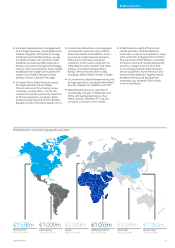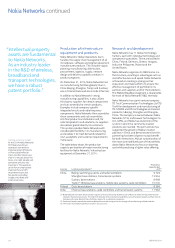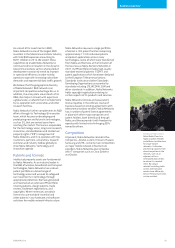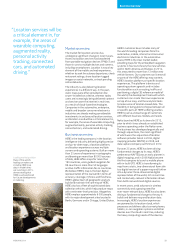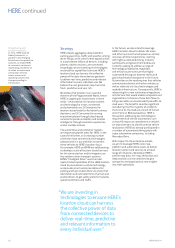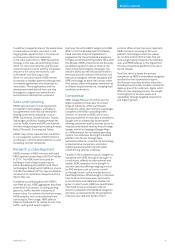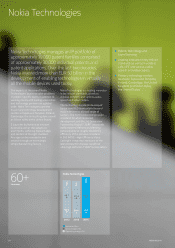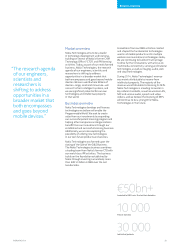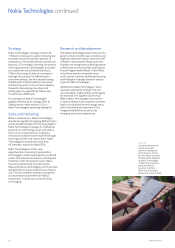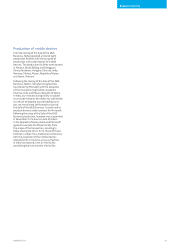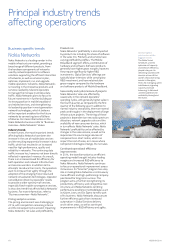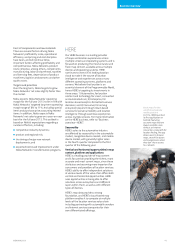Nokia 2014 Annual Report Download - page 33
Download and view the complete annual report
Please find page 33 of the 2014 Nokia annual report below. You can navigate through the pages in the report by either clicking on the pages listed below, or by using the keyword search tool below to find specific information within the annual report.
Business overview
31NOKIA IN 2014
In addition to opportunities in the automotive
and enterprise markets, we invest in and
target growth opportunities in the internet
and consumer electronic industries.
In the latter part of 2014, HERE focused its
strategy in this area, de-prioritizing certain
direct-to-consumer activities and focused
more of resources on its work for customers
who are in the consumer markets, such
as Microsoft and Samsung. In the
direct-to-consumer space, HERE intends
to maintain a modest presence through web
and mobile applications that showcase its
core assets. These applications and the
development work behind them are also
leveraged to support our work with our
automotive and enterprise customers.
Sales and marketing
HERE’s core business is licensing content
and platform technologies, and today it
has agreements with most of the world’s
leading automotive companies, such as
BMW, Continental, Daimler, Nissan, Toyota,
Volkswagen and Volvo; leading enterprises
such as FedEx, Oracle and SAP; and internet
and technology companies including Amazon,
Baidu, Microsoft, Samsung and Yahoo.
HERE’s map content powers four out of ve
in-car navigation systems in North America
and Europe, and its location platform is used
by leading internet companies.
Research and development
HERE’s business is R&D-intensive with total
R&D expenses amounting to EUR 545 million
in 2014. The HERE team is focused on
building and enriching its core map, as
well as developing the platform and cloud
technologies through which HERE can ensure
the eective delivery of the map and location
services to its customers irrespective of the
device they use.
In addition to collecting data with HERE’s
own eet of cars, HERE aggregates data from
another 80 000 sources, including parking,
gas price, trac, weather and points of
interest data. To maintain the freshest maps,
HERE compiles, tests and publishes them
continuously. From usage, HERE collects
billions of data points to update its real-time
trac, routing and search engines.
A primary focus for HERE’s longer-term R&D
eorts is on the development of software,
cloud and data analytical capabilities in
preparation for the anticipated emergence
of highly automated driving before the end of
the decade. HERE’s investments are focusing
on addressing what it sees as three of the
most critical technological challenges: the
vehicle’s ability to precisely localize itself on
the road, what lies ahead of the vehicle, and
how can we program vehicles equipped with
HERE technology to drive like humans rather
than robots, albeit with greater awareness of,
and faster responsiveness to, changing road
conditions and events.
Competition
HERE, Google Maps and TomTom are the
largest suppliers of map data to a broad
range of industries. Other participants
include Inrix, which, like TomTom and Google,
competes with HERE in providing trac
services. In contrast to HERE, which has a
licensing model for its map data and platform,
Google uses an advertising-based model
allowing consumers and businesses to use its
map data and related services free of charge.
Google, which has leveraged Google Maps
as a dierentiator for its Android operating
system, has ambitions to bring the Android
platform into the car through Open
Automotive Alliance, a coalition of technology
and automotive companies, and is also
exploring automated driving with pilots
of self-driving vehicles underway.
To date, in the automotive space, Google has
competed with HERE through its brought-in
car solutions, oered via smartphones and
tablets. HERE competes in the brought-in
solution space by oering mapping services
via PND vendors such as Garmin, as well
as through its own native smartphone and
tablet applications. While brought-in solutions
have become more pervasive, particularly
as smartphone and tablet penetration has
grown in recent years, HERE has nevertheless
continued to see an increase in the car
industry’s adoption of embedded navigation
solutions, as represented by the proportion
of all new cars sold with factory-tted
systems. While content remains important,
HERE has been increasing its focus on
platform technologies which can power
up-to-date and predictive maps that are
increasingly tailored towards the individual
user, and HERE believes in this regard that
the only competitive platform to its own is
that of Google.
TomTom, which is today the primary
competitor to HERE in embedded navigation
solutions for the automotive industry,
also licenses map data to other industries,
including the consumer markets, and counts
Apple as one of its customers. Apple, which
oers its own mapping service, has sought
to strengthen its location assets and
capabilities through targeted acquisitions
and organic growth.




